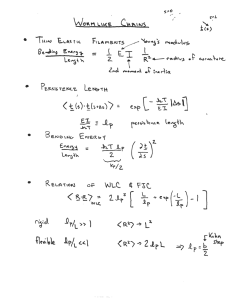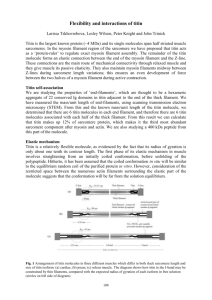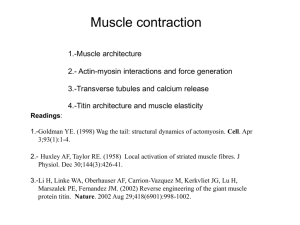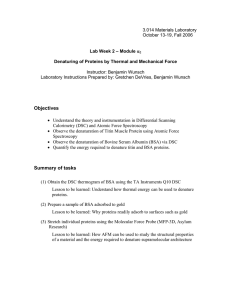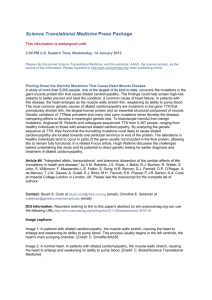Case Study: Titin Ig domains - Theoretical and Computational
advertisement
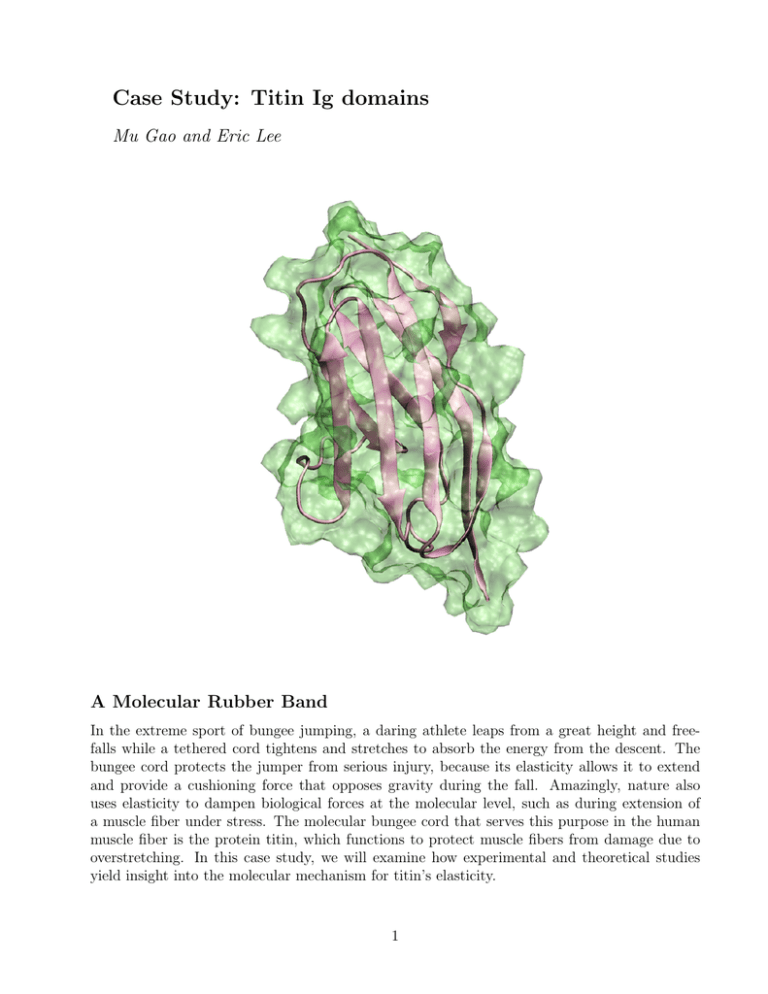
Case Study: Titin Ig domains Mu Gao and Eric Lee A Molecular Rubber Band In the extreme sport of bungee jumping, a daring athlete leaps from a great height and freefalls while a tethered cord tightens and stretches to absorb the energy from the descent. The bungee cord protects the jumper from serious injury, because its elasticity allows it to extend and provide a cushioning force that opposes gravity during the fall. Amazingly, nature also uses elasticity to dampen biological forces at the molecular level, such as during extension of a muscle fiber under stress. The molecular bungee cord that serves this purpose in the human muscle fiber is the protein titin, which functions to protect muscle fibers from damage due to overstretching. In this case study, we will examine how experimental and theoretical studies yield insight into the molecular mechanism for titin’s elasticity. 1 These are the files you will need to complete the exercises in this case study. 2 The Muscle Fiber and Titin Striated muscle, such as a skeletal or cardiac muscle, is a complex of elongated fibers arranged in parallel order and held together with connective tissue. These muscle fibers are typically 2 to 3 cm long and 100 µm in diameter. Each fiber consists of thread-like fibrils (1-2 µm diameter) known as myofibrils, which primarily contain thick filaments (12-18 nm diameter) and thin filaments (5-8 nm diameter). The thick filaments are structures built primarily from overlapping myosin proteins, which have globular heads that form cross bridges connected to thin filaments formed mainly by actin bundles. Viewed lengthwise, the myofibril is seen as a series of bands of alternating composition, separated by line-like regions (Fig 1a and b). The A band is a set of stacked thick filaments centered on the M line, overlapped on both sides by thin filaments, which compose the I band. In between each I band, a dense vertical region called the Z line divides the myofibrils into a functional unit called the sarcomere, which is the smallest self-contained contractile unit (resting length 2 to 3 µm) of the striated muscle. Figure 1: (a) The electron microscope image of striated muscle (photograph courtesy of Dr. Roger Craig, University of Massachusetts) and schematic views of (b) the muscle sarcomere and (c) the structural components of the giant protein titin. Titin Ig and FnIII domains are shown in circles and ovals, respectively. Five Ig domains and one FnIII domain with known atomic structure are labeled. One very specialized structure in a sarcomere is the giant muscle protein titin, which is the largest protein identified in nature, with a molecular weight of nearly ∼4 MDa and a contour length of ∼1 µm [1, 2]. Anchored at the Z and M lines, a string-like titin molecule spans half of the sarcomere in close contact with the thick filament along the A band, but flexible along the I band (Fig 1b and c). The major structural components of titin are bead-like β-sandwich protein modules, most notably the immunoglobulin-like domains, or Ig domains, named after immunoglobulin where the homologous structural motif was first identified. The stable core of an Ig domain is formed from strands of β-sheets, connected through flexible loops from which protrusions form binding sites for antigens in immunoglobulins. However, in titin the Ig domains are not involved in immunological recognition. Instead, they contribute to the passive stiffness of a stretched sarcomere. 3 Titin is the molecular spring in a muscle sarcomere Muscle force generation is dependent on the contractile and stretching motions that take place in the sarcomere. The contractile movement generates active force while the stretching movement generates passive force. The combination of active and passive forces within muscle fibers ultimately gives rise to the muscular force required for various physical motions, such as your heart beating, walking, or turning this page (not yet!). At the molecular level, the contractile motion is due to the sliding of myosin filaments over the actin filaments. Triggered by the release of calcium ions upon muscle excitation and powered by the hydrolysis of ATPs, a series of conformation changes occur in myosin cross-bridges that associate with actin filaments. These conformational changes induce a power stroke event that pulls the thin filament past the thick filament and towards the central M-line at a rate of up to 15 µm/s, exerting the active force. In contrast, when sarcomere is relaxed and further stretched beyond its slack length, a passive force develops to dampen the force of extension and restore the sarcomere to its resting length. An essential characteristic of striated muscle is its elasticity, a mechanical property necessary for the reversible contractile and stretching movement of sarcomere. This elasticity permits myofibrils to be stretched to twice their resting length without damaging their structure. The physiological sarcomere length ranges from 1.9 to 2.5 µm in cardiac muscle and 2.2 to 3.8 µm in soleus, a skeletal calf muscle. Investigations of myofibrils during contraction and relaxation suggest that neither actin nor myosin filaments confer the elasticity seen during force generation, since the length of both filaments appear unchanged during the contraction-extension cycle. Instead, the elastic property of sarcomere appears to arise from another set of muscular filaments, composed of the protein titin. It is the lengthening of titin molecules that generates the passive force which is crucial for maintaining the integrity of the sarcomere. Electron micrographs and gene sequence analysis reveal that the architecture of titin is built upon a linear assembly of 300 immunoglobulin-like (Ig) or fibronectin III-like (FN-III) domains, in addition to several uncharacterized segments. In the A-band or Z-line regions, titin intimately associates with proteins located in the thick and thin filaments, respectively. The only part of titin that appears to move freely is its I-band region, which provides the major contribution to passive elastic properties for the sarcomere. Titin I-band domains of variable composition, called isoforms, have been found in different types of muscle tissue, indicating that the specific distribution of domain types within the titin spring determine its stiffness and extensibility. Molecular fine tuning for the titin spring Approximately ninety percent of titin’s mass by composition lie in the globular Ig or FN-III domains (Fig 1c). Each domain consists of ∼100 residues folded into a β-sandwich motif. The titin A-band is built from highly conserved Ig or FnIII domains that are arranged in regular patterns correlating to the structural composition of associated thick filaments. The repeating patterns seen in both titin and myosin leads to the hypothesis that the titin A-band may regulate the assembly of myosin in the early stage of muscle development. In contrast, the components of titin I-band exhibit prominent passive elasticity that characterizes the spring-like property of the sarcomere. The termini of titin I-band are composed of two well conserved Ig segments, the distal (15 Ig domains) and the proximal (22 Ig domains) segments, respectively. The two segments are connected by three isoform-dependent segments: (i) a variable length Ig segment, 4 (ii) PEVK region, named due to the abundance of proline (P), glutamic acid (E), valine (V), and lysine (K), and (iii) N2 (N2A and/or N2B) regions. The PEVK and N2 regions, rich in charged residues and prolines, do not form stable secondary structures and unfold completely upon stress, elongating two to four times their folded length during muscle extension. In contrast to the flexible PEVK and N2 domains, Ig domains appear to be designed to resist extreme tension and even unfold reversibly at a higher load as the stretch in the sarcomere continues. Thus, the resistance to stress and the reversible unfolding of Ig domains provide a mechanism to prevent over-stretching of muscle. Figure 2: (a) Structure of Titin Ig domain I27, (b) and (c) Structural alignment and protein sequence comparison of five human titin Ig domains: I1 (PDB code: 1G1C), I27 (1TIT), Z1 (1RJ0), Z2 (1RJ0), M5 (1TNM). Details of how to align these five Ig domains and reproduce the snapshot (c) with the program VMD are given in Exercise 1. The composition of a bungee cord determines how much it will stretch during a jump. For example, sheathed bungee cords typically have a rubber core surrounded by a nylon wrapping and stretch to around twice their resting length during a jump. In contrast, all rubber cords consist of many tiny strands of rubber wound together to form one solid cord, and typically stretch to four times their resting length during a jump. The elasticity of I-band titin follows a similar scheme where its composition determines whether it is stiff or elastic. Instead of rubber strands, titin is built from protein segments with different folds, and the ratio of these folds determine to what extent the sarcomere can stretch and still reversibly recover to equilibrium length without permanent damage. The complete sequence of the human titin gene contains 363 exons that potentially encode a total of 38,138 amino acid residues [3]. One third of titin exons are differentially expressed, 5 giving rise to variants with variable domain compositions. For example, the titin isoform found in the human soleus, a leg muscle, contains an extended (ten times longer) PEVK region, and four times as many Ig domains compared to the cardiac titin isoform [4]. Thus, these titin isoforms possess fine-tuned elastic responses for different types of muscle. The elastic behavior of coiled PEVK or other unique domains appear easy to understand because they do not form stable structures. In order to understand why Ig domains are mechanically so stable, however, it is necessary to look more closely at their detailed atomic structures and investigate how they respond to external force. Exercise 1: 3D Structures of Titin Ig Domains. In this VMD exercise you will inspect and align the atomic structures of five titin Ig domains shown in Fig. 2. To load the coordinates of these proteins, start a new VMD session and open the state file titin-Ig.vmd. • After loading, all structures other than I27 are in hidden mode. Select the New Cartoon representation to view the structure of I27. You should get a view similar to what is shown in Fig. 2a. • Make all other Ig domains visible, and align all five titin domains using VMD. This is accomplished by choosing the Multiple Alignment tool from the Extensions menu on the VMD Main window. Then, under the Alignment tab, choose Run Structural Alignment. Fig. 2b shows the aligned domains using the default parameters. The resulting assemblage of aligned structures were colored by the degree of structural similarity (Qa). The color scale ranges from blue (most similar) to red (least similar). You can clearly see that all five titin Ig domains surveyed here have highly conserved β-sandwich structures. • Can you think of another protein family for which a structural alignment would reveal the conservation of functional domains? • Generate a sequence comparison from the structural alignment of our five titin Ig domains as shown in Fig. 2c. The highlighted blocks show regions where structure is conserved with Qa value ≥0.8. • Comparison studies between sequence alignments of proteins with known structure have shown that conserved sequences lead to conserved structure. Can the same be stated vice versa, i.e., that conserved structure implies conserved sequence? Ig domains possess a β-sandwich motif Titin I27 is the first structurally determined Ig domain from the I-band region responsible for regulating passive elasticity for muscle sarcomere [5]. Two β-sheets of I27, the ABED sheet and the A’GFC sheets, are tightly connected at the terminal regions through a straightened loop between the A- and the A’-strands, as shown in Fig. 3. To prevent spontaneous unraveling, two sets of inter-strand hydrogen bonds firmly lock the terminal regions. The two sets of hydrogen bonds include two bonds between a pair of charged residues Lys6 and Glu24 on the A- and the B-strands, and five bonds between the A’- and G-strands. Each set may expand by acquiring an additional dynamic hydrogen bond at their edges. 6 Figure 3: The structure of titin I27 in various representations. (a) The hydrogen bonding at two terminal regions. (b) The cartoon representation rotated 90◦ with respect to (a). (c) Prolines in loop regions. The hydrogen bonding network of the β-sheets can be disrupted by proline residues, known as the β-breaker. VMD can be used to display all proline residues of I27, and their effect on secondary structure (see Exercise 2). (d) Schematic diagram of I27. Exercise 2: Structural Characteristics of β-sheets. In this exercise we will explore a few structural characteristics of I27. • With the previous VMD session still loaded, hide all other Ig domains except I27. Create a new representation for backbone atoms (use the selection text backbone and within 1.5 of betasheet) and choose the Hbond drawing method. The hydrogen bonds are not apparent in this selection with the default settings. Therefore to view a greater number hydrogen bonds, try increasing the distance cut-off and angle cut-off settings (a distance cut-off of 5.0 should be adequate). Create a new CPK representation for backbone atoms between A- and B-strands (residue 3 to 6, 24 to 26) and between A’- and G-strands (residue 9 to 15, 83 to 87). Compare your hydrogen bonds to Fig. 3a. • Most β-strands of I27 are aligned in anti-parallel fashion, where nearly all the polar amide groups from one strand are hydrogen bonded at 90◦ angle to the backbone carbonyl oxygen of the opposing strand whose directionality is reversed. Parallel β-strands also exist in nature but are more rare, and feature hydrogen bonding to neighboring strands at a diagonal angle. Find a pair of β-strands arranged in parallel fashion on I27. • Based on the representation you created above, what role do you think hydrogen bonds may play in stabilizing the β-sheets? • Using the same structure you loaded above, find all prolines in I27. Where are the proline residues located in titin I27? What unique structural feature of proline makes it distinct from all the other amino acids? Knowing that, does this explain their positions in I27? The rigid molecular structure of a titin Ig-fold is the determinant of its ability to bear mechanical stress. A typical titin Ig fold consists of ∼100 residues packed into two β-sheets 7 approximately 40 Å long. The three-dimensional structures of five known titin Ig domains, I1 and I27 (I-band), Z1 and Z2 (N-terminus Z-line), and M5 (C-terminus M-line), each exhibit an eight- or nine-stranded β-sandwich arranged mostly in antiparallel fashion. An exception exists for the A’-and G-strands, which are cross-linked in parallel (Fig. 2). Structural alignment of these five domains reveal that there is a high structural homology between Ig domains. See Exercise 1 for details on performing structural alignment of proteins using the program VMD. The structural and sequence comparison suggest that all titin Ig domains belong to a common Ig I-set superfamily, which also include Ig domains found at many cell surface receptors. Exercise 3: I27 Contact Map. In this exercise we will use VMD to examine physical interactions between β-sheets in I27 titin. VMD’s Contact Map tool, accessed from the Extensions menu, provides a method for viewing residue-residue contacts between two sets of selected atoms. The Cα to Cα distances are produced on the plot, with black as the highest intensity corresponding to 0.0 Å distance, a linear gray scale for 0.0 to 10.0 Å distance, and white when equal to or greater than 10 Å. • Pair scanning: Scroll over the contact map while holding down button 2 (middle button on Linux and Windows PC, right button on MacOSX) to view the resid number and alphacarbon distances between the residue pair selected. • The zoom slider bars on the left side sets the residue numbering scale for both the vertical and horizontal axes. The Fit All option will scale the axes for the window size. • We have provided a contact map of I27 titin Ig domain. Contact between β-strands B4 and B5 (C and F from Fig. 3) are shown in the figure as an example (labeled as 1). • Generate this contact map on your own in VMD for I27. (Hint: Make sure only titin I27 is loaded into VMD.) Can you identify the contacts labeled by 2 and 3 in the figure? • How do contacts between adjacent β-sheets show up in the contact map? 8 Probing the mechanical stability of titin Ig domains in vitro The mechanical properties of titin Ig domains have been investigated experimentally with atomic force microscopy (AFM) or optical tweezers, techniques that can be used to apply force as weak as several pN to a single molecule and resolve corresponding conformational changes at the Å level. Combined with protein engineering, these sensitive methods permit the controlled stretching of a molecule made up of identical protein repeats, providing a unique opportunity to study the mechanical properties of individual titin domains. In an AFM experiment, a cantilever probe is situated on the surface of a protein molecule anchored on the substrate. The substrate is retracted at a constant velocity, causing the cantilever tip to bend. The bending deflects a laser beam pointed to the tip, and the force applied to the molecule can be measured through the deflection. Fig. 4 shows a diagram of stretching seven titin Ig domains, along with a characteristic sawtooth pattern on the force-extension profile obtained from the AFM experiment [6]. The spacing between force peaks matches the contour length of a fully unfolded Ig domain, indicating that the Ig domains unfold in a one-by-one fashion. One may guess that the force peaks induced critical conformational changes that lead to domain unfolding. However, it is not clear from experiments alone what these conformational changes are and how the protein responds to mechanical force. Figure 4: Probing the mechanical properties of individual titin Ig domains using atomic force microscopy [6]. The molecule stretched consists of seven I1 and I27 domains linked alternately. (c) Shows one sawtooth peak in detail. The stages of extension are defined by 1) the phase where force builds as the protein provides resistance to mechanical stretching, and 2) the moment where force bearing elements rupture, leading to a sharp decline of force measured when continued extension. 9 Unraveling the terminal β-strands initiates the I27 unfolding process Obviously the answer to above questions lies at the β-sandwich structure of titin Ig domains that define their mechanical response upon external stress. To address these important questions, computational studies have provided insights into the structure-function relationship of Ig domains at the atomic level [7–9]. Fig. 5 illustrates the conformational changes to I27 during stretching of the domain. The N-terminus was fixed and the C-terminus attached to a harmonic spring that was pulled at its other end at various constant velocities. At first, the terminal regions of the protein straightened with the applied force, and the two β-sheets slid slightly with respect to each other, reaching an extension of ∼10 Å. At this initial stage, the overall secondary structure of I27 remained intact. Upon further extension by ∼5 Å, the increasing force caused two terminal β-strands, the A-strand of ABED sheet and the A’-strands of the A’GFC sheet, to unravel, leading to a rapid unfolding process and decrease of the measured force. The force was measured by monitoring the spring extension. Figure 5: The mechanical unfolding pathway of titin I27. The trajectory of this unfolding process is provided for study. See Exercise 4 for details. The unfolding process of an Ig domain during the SMD simulation can be divided into three stages: i) extension from 0 Å to 10 Å where the molecule is straightened without losing its secondary structure, ii) extension from 10 Å to 15 Å where a pronounced peak force is required to initiate the disruption of the secondary structure, namely detachment of A- and A’-strands, and iii) extension beyond 15 Å where the remaining β-strands unravel rapidly. It is important to note that a large force is not necessary to unfold the protein if a weaker force is applied for a longer duration. For example, the peak force required for unfolding the protein decreases 50% as the stretching velocities are slowed 20 fold from 0.5 Å/ps to 0.01 Å/ps. Under physiological conditions a stretching force as weak as 20 pN can unfold a titin Ig domain within one second. 10 Exercise 4: Forced Unfolding of I27. The forced unfolding of titin Ig domain I27 has been simulated by fixing the N-terminus and pulling the C-terminus with an attached harmonic spring. A 3ns trajectory and a related data file from an SMD simulation at the pulling velocity of 0.05 Å/ps are provided for study. To start, launch VMD and load the state file I27-unfolding.vmd. • Play the trajectory and identify which part of the protein becomes unfolded first. A few snapshots of the unfolding pathway are shown in Fig. 5. • The applied force and resulting extension was recorded in the data file I37-smd-cv-0.05Aps.dat. Make plots of time versus force and extension versus force. Correlate the force peak to the disruption of the secondary structures of the protein. • During the simulation, the Cα atom of the N-terminus was held fixed, while the Cα atom of the C-terminus was pulled along the vector connecting these two atoms. What would happen if one applies the force in a direction orthogonal to the original pulling direction? Terminal inter-strand hydrogen bonds characterize the stability of Ig domains The atomic details obtained from simulations on the unfolding of I27 reveal key structural changes that explains the distinct force peak observed in AFM experiments as shown in Fig. 4. The force peak correlates to separating two pairs of β-strands near the terminal regions of the Ig domain, namely the A- and B-strands and the A’- and G-strand. The interactions between these β-strands contribute significantly to the mechanical stability of this domain. In particular, the force peak corresponded to the rupture of inter-strand hydrogen bonds between the A- and the B-strands and between the A’- and the G-strands as shown in Fig. 6. Figure 6: The disruption of the A-B and A’-G inter-strand hydrogen bonds of I27 correlates with the unfolding force peak. See also the attached movie clip I27-smd.mpg. Details of hydrogen bond analysis is discussed in the Exercise 5 below. 11 Prior to the separation of the A- and the A’-strands at 10 Å extension, all hydrogen bonds between the ABE and the A’GF β-sheets are well maintained. As the force reaches its peak during the extension to 12 Å, two hydrogen bonds between the A- and the B-strands break, closely followed by the concurrent burst of hydrogen bonds between the A’- and the G-strands at ∼14 Å. At this phase, the hydrogen bonds between other β-strands, such as between the B- and E-strands, and between the G- and F-strands, remain intact. However, as the A- and A’-strands fully extend, the remaining hydrogen bonds are sequentially disrupted in an unzipping fashion, requiring a much lower force to break than the major force peak. During the unfolding process water molecules play an important role by forming new hydrogen bonds with the original protein backbone atoms that have ruptured inter-strand hydrogen bonds. Insights gained from atomic details provide guidance for modulating the mechanical stability of I27 by mutating key amino acids. A point mutation disrupting the inter-strand hydrogen bonds, for example, by replacing one hydrogen bond forming amino acid on G-strand with a proline, destabilizes the stability of the module. AFM experiments of these point mutants have indeed shown decreased mechanical stability [10]. Mechanical properties of a titin complex Up to this point our examination of titin has been restricted to individual Ig-domains. Titin however, interacts with a variety of proteins along its ∼1 µm long length. These interactions provide structural support for the development and function of myofibrils and also regulatory roles such as responding to stretching forces developed in titin. The majority of these interactions occur at the A-band where titin interacts with myosin filaments, and at the terminal ends where it is anchored at the sarcomeric Z-line and M-line and binds with dozens of proteins. At the very N-terminal region of titin, a sensor complex is formed based on two titin Ig domains, Z1 and Z2. The core part of this complex relies on the anchoring of Z1 and Z2 through the ligand telethonin [11, 12]. Telethonin is one of the most abundant transcripts in striated muscle. Studies have revealed that the presence of telethonin, in conjunction with titin Z1Z2, is required for progression of muscle growth, and it is highly specific for both titin Z1 and Z2, but not for Z1 or Z2 individually [13]. Point mutations to telethonin resulting in premature stop codons have been correlated to a form of limb girdle muscular dystrophy (type 2A) [14–16], suggesting that telethonin plays a major role in the stabilization of N-terminal titin at the Z-disc. The crystal structure of telethonin in complex with titin Z1 and Z2 has revealed a novel binding motif between Ig domains and a ligand [17]. Unlike typical ligand-binding through insertion of the ligand into a receptor binding pocket, in this crystal structure the receptor Z1Z2 domains of two antiparallel titin N-termini are surprisingly joined together by an N-terminal fragment of the ligand telethonin through β-strand cross-linking (see Fig 7), a structural motif that appears in pathological fibril formation. 12 Exercise 5: Mechanical stability and interstrand hydrogen bonds. In order to understand how the force-bearing β-strands of I27 contribute to the mechanical stability of the protein, we monitor the conformational changes connected with the rupture and subsequent unfolding of the protein. For this purpose we analyze a SMD simulation at a pulling velocity of 0.01 Å/ps. The corresponding trajectory reveals the key unfolding step, the detachment of the A’- and A-strands. To start, launch VMD and load the state file I27-hbond.vmd. • Find all inter-strand hydrogen bonds formed between A- and B-strands and between A’and G-strands (refer to Fig 3), and monitor the change of the bonding length (the distance between the hydrogen and the oxygen of a hydrogen bond) during the trajectory. You should obtain plots similar to what shown in Fig. 6. Which set of hydrogen bonds break first? • The applied force and resulting extension was recorded in the data file I27-smd-cv-0.01Aps.dat. Make plots of time versus force and extension versus force, and correlate the force peak to the breakage of the hydrogen bonds. • Hydrogen bonds may form between bonding pairs as they align during the stretching process. Identify an inter-strand hydrogen bond that was broken initially but re-formed briefly when an alternate bonding pair aligns. One can further analyze the hydrogen bond energy with the following empirical formula used by CHARMM22: EHBond = ( A B − 4 ) cos2 (θA−H−D ) cos2 (θAA−A−H ) 6 rAD rAD 2 2 2 2 2 2 , rhof SW (rAD , rhon f ) SW (cos (θAD ), cos (θhon ), cos (θhof f )) where rAD , θA−H−D , θAA−A−H are the distance between the acceptor (A) and the donor (D), the angles formed by connecting the acceptor, the hydrogen (H) and the donor, and the angle formed by connecting the acceptor antecedent (AA), the acceptor and the hydrogen, respectively. SW is a switch function defined as SW (R, Ron , Rof f ) = 0 (R2 − R2 if R > Rof f 2 2 2 2 2 2 2 of f )(R − Rof f ) (R − Rof f −3(R − Ron ) 2 2 3 (Rof f − Ron ) 1 if Rof f > R > Ron if R < Ron A tcl script hbond.tcl for calculating and visualizing the hydrogen bond energy using the above formula is provided. With the trajectory still loaded, open the VMD TkConsole and type source hbond.tcl. When the calculation is completed, all inter-strand hydrogen bonds will appear in bond representation. The strength of the bond is indicated by the color scale transiting gradually from green (stronger) to blue (weaker) and eventually broken. A MPEG movie clip I27-smd.mpg of this visualization is available for view. • Display water molecules that are in the proximity (within 2.5 Å) of partner atoms forming AB and A’G inter-strand hydrogen bonds. • Make sure your selection of water molecules updated along the trajectory, and observe how water molecules participate the unfolding process. 13 Figure 7: Structure of titin Z1Z2-telethonin complex. (A) Cartoon representation of two separate N-terminal titin Z1Z2 Ig-domains joined by one N-terminal telethonin molecule fragment (residues 1 to 89). Two titin molecules are individually colored blue and red (ZA and ZB , respectively). Telethonin is colored in yellow. The β-strands involved in critical force bearing contacts for each titin Ig-domain (AB and A’G) and between each titin Z2 module and telethonin are labeled (GB and GD). (B) Detailed schematic of β-strand alignment for the T2 T complex, with force bearing hydrogen bonds shown for β-strand pairs AB and A’G for titin domains, and hydrogen bonds linking the G-strands on the Ig domains to the A,B,C, and D-strands on telethonin. See Exercise 6 to inspect the complex with VMD We have shown in earlier sections that single titin Ig-domains such as I27 are well suited for bearing a mechanical force. The discovery of titin Z1Z2 Ig-domains in complex with telethonin naturally poses questions: Are the force bearing properties of these Ig-domains affected by their interaction with telethonin? What are the mechanical features of force bearing protein complexes, as opposed to individual proteins, and why are they important? Using a similar computational approach described above in studies of titin I27, we now investigate the Z1Z2-telethonin complex in order to answer the questions posed above. It turns out that the mechanical stability of the complex is much stronger than individual Ig domains [18]. Destabilizing the complex by stretching the titin Z2 terminal ends of the complex requires higher peak force than that required for unfolding single titin Ig-domains such as I27 (a force peak of nearly 1900 pN for Z1Z2-telethonin as seen in Fig. 8 vs. a force peak of 1500 pN for I27 as seen in Fig. 5). Whereas previous studies have revealed that the unraveling of the β-strands for titin Ig-domains constitutes the dominant unfolding barrier, in the case of Z1Z2 in complex with telethonin, the force peak observed corresponded to a detachment of one virtually intact Z2 domain from a β-strands of telethonin (see Fig. 8 a-d). 14 This discovery sheds light on a key architectural strategy that the titin Z1Z2-telethonin complex employs to yield extraordinary resistance to mechanical stress. The major force bearing component of this complex is an extensive intermolecular hydrogen bonding network formed across β-strands between telethonin and Z1Z2 domains, and not intramolecularly between termini β-strands of individual Z1 or Z2 domains. This shift to a stronger force bearing interface reduces the chance of the unraveling the individual Ig-domains, thus stabilizing the complex. This example demonstrates how β-strand cross-linking via hydrogen bonds serves as an important mechanism, in effect a molecular glue, for augmenting the ability of protein complexes designed to resist mechanical stress. Figure 8: Mechanical stability of the titin Z1Z2-telethonin complex. The force vs. extension profile in the plot illustrates that a force peak of nearly 2000 pN is required to detach a Z2 domain from telethonin under constant velocity SMD simulation with a pulling velocity of 0.05Å/ps. (a)-(d) represent the initial, inter-molecule β-strands detachment, further separation, and subsequent unraveling states, respectively. The color code is the same as defined in Fig. 7, except that the four G-strands forming β-strands with telethonin are colored in grey. A movie taken from our simulation illustrating this process has been provided under Exercise 6. 15 Exercise 6: The mechanical function of a molecular glue. In the previous section we discussed the forced unfolding of the titin Z1Z2-telethonin complex. We have included a movie, z1z2-tlt-smd.mpg, generated from the simulation illustrating the detachment of a titin Z2 domain from telethonin. Here we will examine the structural feature that contributes to the superior resistance to mechanical stress the complex exhibits. To start, launch VMD and load the state file z1z2-tlt.vmd. • The initial view will be of the Z1Z2-telethonin complex in the drawing method structure similar to that shown in Fig. 7. The two individual titin chains, ZA and ZB, have been colored separately, but each contains two titin domains, Z1 and Z2. Use the Sequence Viewer under the menu Extensions > Analysis in order to identify Z1 and Z2, and their relative orientation to each other. • Are the two titin chains aligned parallel or antiparallel? What implications to the force bearing ability of the complex do you think would occur for each scenario? • Titin binds to telethonin via β-strand hydrogen bond crosslinking. This requires β-strands from both titin and telethonin to align lengthwise, in order to permit the β-sheet to form between the G-strands of the titin domains and the ABCD-strands of telethonin. Refer to Fig. 7 for a diagram with the orientation of the β-strands, and make a new selection under Graphical Representations of the backbone atoms for one of the titin G-strands and its associated binding strand on telethonin using the CPK drawing method and coloring method name. For example, you can make a selection for the G-strand on domain Z1 of molecule ZA, and the A-strand of telethonin. You will probably need to keep the Sequence Viewer window open to verify the proper selections. • Create a third representation which combines the two selections you made above but this time, select Hbonds as the drawing method, and coloring method to colorID 1. Increase the cutoff angle (to 35) and distance (to 4.0) settings until you can comfortably see the dashed red lines representing hydrogen bonds. Hide all selections under representations except for the three you have just made, and then use Display > Reset View in order to center the screen. You should now be able to see the numerous hydrogen bonds that stabilize the interface between the titin domains and telethonin. Outlook Beside immunoglobulin-like domains, titin also contains fibronectin type III like domains, which has a double β-sheet architecture that is similar to the structure of Ig domains. FnIII domains were best characterized in the extracellular matrix protein fibronectin that forms elastic fibrils connecting cells to extracellular matrix via the integrin receptors at the cell surface. A subtle structural difference between Ig and FnIII domains is that the two β-sheets in a FnIII is loosely connected due to the absence of the A’-strand as I27 exhibits. As a result, the FnIII domain may unravel one β-sheet while the other β-sheet remains virtually intact upon stress. This partial unraveling leads the module to a stable mechanical intermediate with an extension of ∼100 Å. 16 In addition to provide elasticity, the intermediate has profound biological function in regulating adhesion between neighboring fibronectin molecules that assemble into fibrils [19]. References [1] L. Tskhovrebova and J. Trinick. Titin: Properties and family relationships. Nat. Rev. Mol. Cell. Biol., 4(9):679–689, 2003. [2] H. L. Granzier and S. Labeit. The giant protein titin a major player in myocardial mechanics, signaling and disease. Circulation Res., 94:284–295, 2004. [3] A. Freiburg, K. Trombitas, W. Hell, O. Cazorla, F. Fougerousse, T. Centner, B. Kolmerer, C. Witt, J. Beckmann, C. Gregorio, H. Granzier, and S. Labeit. Series of exon-skipping events in the elastic spring region of titin as the structural basis for myofibrillar elastic diversity. Circ. Res., 86:1114–1121, 2000. [4] S. Labeit and B. Kolmerer. Titins, giant proteins in charge of muscle ultrastructure and elasticity. Science, 270:293–296, 1995. [5] Sabina Improta, Anastasia Politou, and Annalisa Pastore. Immunoglobulin-like modules from titin I-band: extensible components of muscle elasticity. Structure, 4:323–337, 1996. [6] H. Li, W. Linke, A. F. Oberhauser, M. Carrion-Vazquez, J. G. Kerkvliet, H. Lu, P. E. Marszalek, and J. M. Fernandez. Reverse engineering of the giant muscle protein titin. Nature, 418:998–1002, 2002. [7] Hui Lu, Barry Isralewitz, André Krammer, Viola Vogel, and Klaus Schulten. Unfolding of titin immunoglobulin domains by steered molecular dynamics simulation. Biophys. J., 75:662–671, 1998. [8] Mu Gao, Matthias Wilmanns, and Klaus Schulten. Steered molecular dynamics studies of titin I1 domain unfolding. Biophys. J., 83:3435–3445, 2002. [9] Mu Gao, Hui Lu, and Klaus Schulten. Unfolding of titin domains studied by molecular dynamics simulations. J. Muscle Res. Cell Mot., 23:513–521, 2002. [10] H. Li, C. V. Mariano, A. F. Oberhauser, P. E. Marszalek, and J. M. Fernandez. Point mutations alter the mechanical stability of immunoglobulin modules. Nature Struct. Biol., 7:1117–1120, 2001. [11] G. Valle, G. Faulkner, A. DeAntoni, P. Pacchioni, A. Pallavicini, D. Pandolfo, N. Tiso, S. Toppo, S. Trevisan, and G. Lanfranchi. Telethonin, a novel sarcomeric protein of heart and skeletal muscle. FEBS Lett., 415:163–168, 1997. [12] C. C. Gregorio, K. Trombitas, T. Centner, B. Kolmerer, G. Stier, K. Kunke, K. Suzuki, F. Obermayr, B. Herrmann, H. Granzier, H. Sorimachi, and S. Labeit. The NH2 terminus of titin spans the Z-disc: Its interaction with a novel 19-kD ligand (T-cap) is required for sarcomeric integrity. J. Cell Biol., 143(4):1013–1027, 1998. 17 [13] G. Faulkner, G. Lanfranchi, and G. Valle. Telethonin and other new proteins of the Z-disc of skeletal muscle. Life, 51:275–282, 2001. [14] M. Itoh-Satoh, T. Hayashi, H. Nishi, Y. Koga, T. Arimura, T. Koyanagi, M. Takahashi, S. Hohda, K. Ueda, T. Nouchi, M. Hiroe, F. Marumo, T. Imaizumi, M. Yasunami, and A. Kimura. Titin mutations as the molecular basis for dilated cardiomyopathy. Biochem. Biophys. Res. Commun., 291(2):385–393, 2002. [15] C. Bonnemann and N. Laing. Myopathies resulting from mutations in sarcomeric proteins. Curr. Op. Neur., 17:529–537, 2004. [16] S. Laval and K. Bushby. Limb-girdle muscular dystrophies - from genetics to molecular pathology. Neuropath. & Appl. Neurobiol., 30:91–105, 2004. [17] P. J. Zou, N. Pinotsis, M. Marino, S. Lange, A. Popov, I. Mavridis, M. Gautel, O. M. Mayans, and M. Wilmanns. Molecular basis of telethonin-mediated linkage of the Nterminus of titin within the sarcomeric Z-disc. Nature, 2005, in press. [18] Eric H. Lee, Mu Gao, Nikos Pinotsis, Matthias Wilmanns, and Klaus Schulten. Mechanical strength of the titin Z1Z2/telethonin complex. Structure, 2005. in press. [19] Mu Gao, David Craig, Olivier Lequin, Iain D. Campbell, Viola Vogel, and Klaus Schulten. Structure and functional significance of mechanically unfolded fibronectin type III1 intermediates. Proc. Natl. Acad. Sci. USA, 100:14784–14789, 2003. 18
